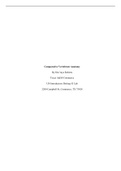Resume
Summary All key words People Management
- Cours
- People Management
- Établissement
- Arteveldehogeschool (Artevelde)
Samenvatting van alle key words van het vak People Management. De woorden komen overeen met de les, de powerpoints en het boek. De woorden komen terug in mijn volledige samenvatting van People Management.
[Montrer plus]













